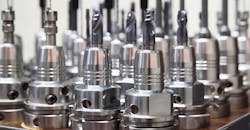Four Ways to Supercharge Tool Life and Shop Throughput
Key Highlights
- Analyze wear patterns like chipping and notching to identify root causes .
- Promote ongoing training and good staff habits.
- Address internal gaps by considering equipment leasing, external services , or strategic outsourcing.
- Implement automation, such as hands-free tool changers, etc.
- Continuously seek novel solutions and set new goals to motivate employees.
Well-chosen process improvements for a machine shop can lower costs, minimize waste and raise productivity. Aiming to extend your cutting tool life is a good place to start, because of the numerous avenues available to achieve the goal. Many manufacturers also want to boost throughput, knowing their success could increase their competitive advantage and adaptability to customer demands. Which proven and practical methods should you prioritize to enjoy measurable improvements?
1. Analyze wear patterns
Improvement-oriented people often say that the first step to progress is understanding where problems exist, and why. You can determine those answers by examining worn tools to find commonalities.
Chipping is a type of wear that occurs when the cutting edge fractures. Although it has numerous possible causes, incorrect machine parameters, and overly long tool lengths are two linked problems.
Notching is another easily recognizable wear type, identified by tool erosion in a single area on the cutting edge. Varying the cutting depth and speed can resolve it.
Knowing how to maximize tool life starts by finding commonalities in the abnormal wear. Can you link all or most cases to a specific machine, employee or fabricated product? Identifying one or more root causes is essential for planning effective strategies.
Do this periodically, realizing that variable factors such as personnel changes, aging machines, or expanded machine shop offerings can temporarily disrupt operations and cause adverse outcomes. Process discovery can get things back on track if you identify the desired objectives and scope before continuing.
2. Develop and retain good habits
Bad habits can worsen tool wear and decrease productivity. After developing those behaviors, it may take time for shop personnel to quit them, so it is better to learn things the right way from the start. You can promote that norm in a machine shop by prioritizing training during and after onboarding.
If your business purchases new machines, give operators ample time to learn how to work with them. They will feel more confident and know which settings to use for specific requirements. Training is also necessary if your business mandates new processes or expands its customer offerings.
Humans naturally resist change, but adaptability is essential for marketplace relevance. Continuing education empowers workers to stay responsive and open, regardless of the future.
Another option is to partner with industry entities for an apprenticeship. Such a program at Los Alamos National Laboratory has taught participants skills that prepare them for the job market. The training allows students to rotate between machine shops, helping them experience real-life workflows and equipment.
3. Recognize and address internal gaps
Even managers of consistently productive machine shops find that their operations cannot handle everything that clients request. Labor shortages, inadequate equipment, or highly specialized orders could cause that result. Once decision-makers notice the shortcomings, they should strategize to solve them.
This might mean subscribing to a machines-as-a-service model, which gives manufacturers access to critical equipment for a monthly or per-usage fee. It is an affordable way to raise output without significant upfront costs.
Leaders also should consider hiring external service providers to relieve manufacturing workloads. Some companies offer expert deburring services that occur internally. This allows machine shop workers to focus on an enterprise’s core competencies with the knowledge that skilled external assistance can do the remainder.
Many leaders initially resist working with outside specialists because they view that option as a relinquishment of control. It often has the opposite effect, allowing them to devote more time to what they can do well and not get caught up in the requirements that cause ongoing challenges better solved by others.
4. Extend tool life with automation
Cutting tool operators have many opportunities to automate parts of their workflow, including if they want to know how to maximize tool life. Technology vendors understand the need to connect their products to users’ pain points and show them how to increase throughput.
One manufacturer of metal cutting products and related innovations revealed the possibilities when introducing a hands-free tool changer. Companies that use it can run machines continuously for up to 16 hours without human intervention. That means operators who formerly supervised automated cutting machines to check for wear can do other tasks.
This offering also minimizes waste because it only changes fully worn tools. While people can make such inspections highly subjective, that issue is less likely when the trained algorithms do the scrutinizing.
Manufacturers who purchase this product can even progress from partial automation to lights-out factories. Those locations increase throughput by operating around the clock, helping producers continue making items as most or all of their competitors close overnight or during weekends.
These proven tips will help machine shops target problems and apply valuable troubleshooting methods. Besides using the most applicable ones, you can extend cutting tool life by constantly seeking new ways to set goals and sharpen processes. That dedication should motivate your employees to keep challenging themselves and produce their best work.
About the Author
Emily Newton
Emily Newton is the Editor-in-Chief of Revolutionized, an online magazine exploring the latest industrial innovations.
